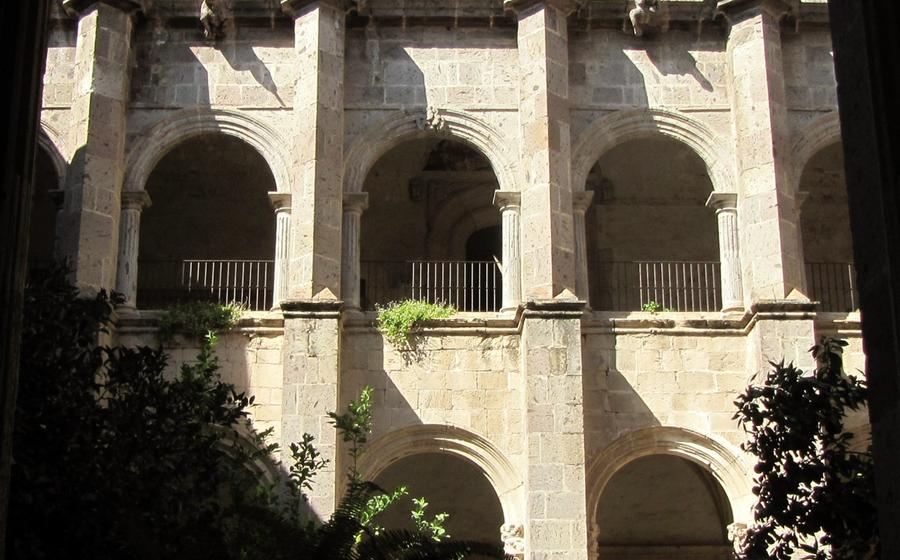
Garden of the Ashes (Jardín de las cenizas)
- A Memento Mori in the Heart of Guanajuato
- The Ashes of Guanajuato's Elite:
- A Walk Through History
- A Place of Reflection and Remembrance
- The Garden's Artistic Legacy
- A Haven for Nature Lovers:
- A Symbol of Mexican Identity:
- Legends and Myths Surrounding the Garden
- The Garden's Restoration and Preservation:
- A Must-See for History Buffs and Culture Enthusiasts
- Planning Your Visit
- Guided Tours and Special Events
- Nearby Attractions and Activities: Exploring Guanajuato's Cultural Heritage
- Capturing the Essence of the Garden
- Insider Tip: Unveiling Hidden Treasures and Cultural Immersion
A Memento Mori in the Heart of Guanajuato
Nestled in the historic city of Guanajuato, Mexico, lies a hidden gem that invites visitors to contemplate the transient nature of life and the enduring legacy of death. The Garden of the Ashes (Jardín de las cenizas), a unique and captivating cemetery, stands as a testament to the rich history, culture, and artistry of this vibrant region.
Located just a short walk from the city center, the garden is easily accessible and welcomes visitors to explore its tranquil grounds. Its unique design, featuring a central courtyard surrounded by arched niches and elaborate tombstones, creates a serene and contemplative atmosphere. The garden's architectural features, including intricate carvings, colorful tiles, and wrought-iron gates, showcase the artistic prowess of Guanajuato's skilled craftsmen.
The Garden of the Ashes was conceived as a resting place for Guanajuato's elite during the 19th century, a time when the city was experiencing rapid growth and prosperity. The garden's creation was influenced by the prevailing cultural and religious beliefs of the era, which emphasized the importance of honoring the dead and commemorating their lives.
The Ashes of Guanajuato's Elite:
The Garden of the Ashes serves as the final resting place for Guanajuato's most illustrious figures, a testament to their indelible contributions to the city's rich history. Among the notable individuals entombed within the garden's hallowed grounds are mining magnates, political leaders, and cultural icons whose legacies continue to shape the city's identity. Their elaborate tombs, adorned with intricate carvings, epitaphs, and inscriptions, narrate their life stories and accomplishments, offering visitors a glimpse into the lives of Guanajuato's most influential personalities.
Prominent among these is the tomb of Don Juan Valenciana, a mining magnate whose wealth and philanthropy left an enduring mark on Guanajuato. His opulent tomb, featuring a life-sized sculpture of the man himself, stands as a symbol of his power and influence. Another notable figure is Doña Josefa Ortíz de Domínguez, a heroine of the Mexican War of Independence, whose tomb bears a poignant inscription that immortalizes her bravery and sacrifice.
The garden also houses the remains of distinguished artists, writers, and intellectuals who played a pivotal role in shaping Guanajuato's cultural landscape. Their tombs, adorned with motifs and symbols that reflect their creative pursuits, pay homage to their contributions to the city's artistic legacy. Among them is the tomb of renowned poet and playwright José Joaquín Fernández de Lizardi, whose works continue to be celebrated for their wit and social commentary.
A Walk Through History
The Garden of the Ashes stands as a testament to Guanajuato's rich and storied past. As visitors wander through its tranquil paths, they are embarking on a chronological journey that spans centuries. Each tomb, each inscription, each architectural detail tells a tale of the city's evolution.
From its humble beginnings as a small cemetery in the 18th century, the garden has grown into a repository of Guanajuato's history. Its tombs mirror the changing burial practices and funerary customs of the city, reflecting the influence of different cultures and traditions.
The garden's architecture, too, bears witness to the city's architectural evolution. From the neoclassical facades of the early tombs to the Art Nouveau flourishes of the later ones, the garden showcases a diverse range of styles that mirror the changing tastes and sensibilities of Guanajuato's society.
Through its tombs, its architecture, and its art, the Garden of the Ashes offers visitors a glimpse into the past, inviting them to explore the rich tapestry of history that has shaped this vibrant city.
A Place of Reflection and Remembrance
The Garden of the Ashes exudes a profound sense of peace and tranquility, inviting visitors to pause and reflect on the circle of life. It serves as a sanctuary where the living can honor the memory of their departed loved ones, fostering a deep connection between the past and the present. In Mexican culture, honoring the dead is a sacred tradition, and the garden embodies this reverence with its serene and contemplative atmosphere.
As visitors stroll through the garden, they are enveloped by a palpable sense of history and remembrance. The tombs and mausoleums stand as silent witnesses to the lives that once were, each holding stories of triumphs and sorrows, love and loss. The inscriptions and epitaphs adorning the tombs offer glimpses into the lives of those laid to rest, inviting visitors to reflect on the fleeting nature of existence and the enduring legacy of human spirit.
The garden is not merely a burial ground but also a place of pilgrimage for those seeking solace and connection with their ancestors. Families gather to pay their respects, to remember cherished moments, and to seek comfort in the knowledge that their loved ones are resting in a place of beauty and tranquility. The garden's peaceful ambiance provides a sanctuary for contemplation, allowing visitors to reconnect with their own mortality and to find solace in the midst of grief.
The Garden's Artistic Legacy
The Garden of the Ashes is a treasure trove of artistic expressions that reflect the rich cultural heritage of Mexico. Notable sculptures, murals, and other works of art adorn the garden, each carrying a unique story and symbolism. Visitors can marvel at the intricate carvings on the tombs, which depict scenes from Mexican history and mythology. The garden also features beautiful murals that showcase the talent of local artists and provide a glimpse into the lives and traditions of Guanajuato's people.
One of the most striking sculptures in the garden is a bronze statue of a woman holding a skull. This sculpture, known as "La Muerte" (Death), symbolizes the inevitability of death and the cyclical nature of life. Another notable work of art is a mural depicting the Virgin of Guadalupe, Mexico's patron saint. This mural is a testament to the deep religious beliefs and devotion of the Mexican people.
The Garden of the Ashes is a living testament to the artistic legacy of Mexico. Its unique expressions of art and culture provide visitors with a deeper understanding of Mexican identity and the country's rich history.
A Haven for Nature Lovers:
Amidst the historical and cultural significance of the Garden of the Ashes, its natural beauty provides a tranquil and serene oasis for visitors. The garden is home to a diverse array of trees, flowers, and plants, each holding cultural and symbolic meaning in Mexican tradition.
Strolling through the garden, visitors are greeted by the vibrant colors and fragrances of bougainvillea, roses, and marigolds, which represent life, love, and remembrance. The towering cypress trees, symbols of eternity and immortality, cast long shadows over the paths, creating a sense of peace and tranquility.
The garden's lush vegetation serves as a sanctuary for wildlife and biodiversity. Birds flit among the branches, their songs creating a harmonious melody. Butterflies flutter from flower to flower, adding a touch of magic to the air. The garden's peaceful atmosphere allows visitors to reconnect with nature and find solace and tranquility amidst the historical and cultural significance of their surroundings.
Nature plays a vital role in providing a sense of tranquility and reflection within the Garden of the Ashes. The vibrant flora adds a touch of color and life to the otherwise somber surroundings, while the lush vegetation provides a serene and peaceful atmosphere. The garden's natural beauty serves as a reminder of the interconnectedness of life and death, and offers visitors a space to contemplate the transience of existence and the enduring power of nature.
A Symbol of Mexican Identity:
The Garden of the Ashes stands as a testament to the rich cultural heritage and profound beliefs of the Mexican people. It embodies the nation's intricate relationship with death and the afterlife, reflecting the syncretism of indigenous and Spanish influences that have shaped Mexican culture.
Death, in Mexican tradition, is not viewed solely as an end but rather a transition to a new phase of existence. The garden exemplifies this perspective, honoring the deceased while celebrating their lives and contributions to society.
The garden's design and imagery draw upon both indigenous and Spanish cultural elements, creating a unique blend of symbolism and iconography. The use of skulls, skeletons, and other الموت-related motifs reflects the indigenous reverence for the afterlife, while the baroque architectural style and intricate carvings showcase the influence of Spanish Catholicism.
The Garden of the Ashes serves as a poignant reminder of the deep-seated beliefs and values that underpin Mexican culture, highlighting the nation's unique perspective on death, remembrance, and the enduring legacy of its people.
Legends and Myths Surrounding the Garden
The Garden of the Ashes is steeped in local folklore and legends, adding to its mystique and captivating visitors' imaginations. Stories of ghosts and spirits haunting the premises abound, with some claiming to have witnessed apparitions or experienced unexplained phenomena within the garden's walls.
One popular legend tells the tale of a young woman who was tragically killed on her wedding day. Her fiancé, grief-stricken and unable to accept her untimely demise, is said to roam the garden, searching for his beloved. Visitors have reported seeing his ghostly figure, dressed in his wedding attire, wandering aimlessly among the graves.
Another legend speaks of a hidden treasure buried somewhere within the garden. It is said that a wealthy merchant, fearing for the safety of his fortune during a time of turmoil, concealed his riches in the garden, marking the spot with a cryptic symbol. Many have searched for this hidden treasure, but none have been successful in finding it.
The garden's reputation for mystical powers and energy is also well-known. Some believe that the garden possesses a unique aura that can influence the lives of those who visit it. Stories of visitors experiencing profound spiritual awakenings or receiving divine guidance within the garden's walls are not uncommon.
These legends and myths have transformed the Garden of the Ashes into a place of mystery and intrigue, attracting visitors who are drawn to its ethereal atmosphere and the allure of the unknown. The garden has become a source of inspiration for artists and writers, who find themselves captivated by its haunting beauty and the tales that surround it.
The Garden's Restoration and Preservation:
The Garden of the Ashes has undergone extensive restoration efforts in recent years, aiming to preserve its historical and cultural significance for future generations. These efforts have involved meticulous cleaning, repairs, and conservation of the garden's structures, artwork, and vegetation. Challenges in the restoration process included addressing structural damage, weathering, and the need to balance preservation with necessary updates.
The restoration team has worked diligently to maintain the garden's original design and integrity while ensuring its safety and accessibility for visitors. This delicate balance requires careful planning, skilled craftsmanship, and a deep understanding of the garden's history. The restoration process has been guided by experts in conservation, architecture, and horticulture to ensure the garden's authenticity and preservation of its unique character.
Preserving the Garden of the Ashes is not only about maintaining a physical space but also about safeguarding a vital part of Guanajuato's cultural heritage. The garden serves as a reminder of the city's rich history, the lives of its notable figures, and the evolution of burial practices and funerary customs. By preserving the garden, we honor the memory of those who came before us and ensure that their stories continue to be told for generations to come.
A Must-See for History Buffs and Culture Enthusiasts
The Garden of the Ashes stands as a significant historical and cultural landmark in Guanajuato, inviting history buffs and culture enthusiasts to delve into the city's rich past. Through its beautifully preserved architecture, poignant inscriptions, and evocative artwork, the garden offers a tangible connection to the lives and legacies of Guanajuato's prominent figures. Visitors can embark on a journey of discovery, gaining insights into the social, economic, and cultural forces that shaped the city's development over the centuries. The garden serves as a valuable educational resource for those seeking to understand Mexican history and culture, providing a poignant reminder of the enduring impact of the past on the present.
Planning Your Visit
To fully appreciate the Garden of the Ashes, plan your visit carefully. The best time to go is during the dry season, from October to May, when the weather is pleasant and the garden is in full bloom. Guided tours in Spanish and English are available, providing insights into the garden's history and symbolism.
Navigating the garden is easy, with well-marked paths and signage. However, comfortable shoes are recommended as the ground is uneven in some areas. Accessibility for visitors with disabilities is limited due to the garden's historical nature, but assistance can be provided upon request.
When visiting the garden, respectful behavior is expected. Avoid loud noises and refrain from touching or climbing on the tombs. Photography is allowed, but be mindful of the privacy of other visitors and maintain decorum. Capture the garden's beauty responsibly, respecting its sacred nature.
Guided Tours and Special Events
To enhance your experience at the Garden of the Ashes, consider joining a guided tour. Knowledgeable guides, often historians or experts in Guanajuato's culture, provide valuable insights into the garden's history, symbolism, and artwork. Guided tours are available in various languages, allowing visitors from diverse backgrounds to appreciate the garden's significance.
Throughout the year, the garden hosts special events and exhibitions that delve deeper into its history and cultural context. These events may include lectures by scholars, art exhibitions inspired by the garden, or traditional Mexican performances. Participating in these special events offers visitors a unique opportunity to engage with the garden on a deeper level and gain a richer understanding of its cultural significance.
Nearby Attractions and Activities: Exploring Guanajuato's Cultural Heritage
A visit to the Garden of the Ashes offers a profound immersion into Guanajuato's history and culture. To fully appreciate the city's rich heritage, consider exploring other nearby attractions that showcase its diverse offerings.
Stroll through the historic city center, a UNESCO World Heritage Site, and admire the colonial architecture that lines its cobbled streets. Visit the Alhóndiga de Granaditas, a former granary that played a crucial role in the Mexican War of Independence. Step inside the opulent Teatro Juárez, renowned for its stunning neoclassical design and vibrant cultural performances.
For a glimpse into Guanajuato's mining past, venture to the Museo de las Momias, home to a collection of naturally mummified bodies discovered in the city's mines. Experience the thrill of exploring underground tunnels and mines at the Mina de Valenciana, once the richest silver mine in the world.
Immerse yourself in the city's vibrant art scene by visiting the Museo Iconográfico del Quijote, which houses a vast collection of artwork inspired by Miguel de Cervantes' masterpiece, Don Quixote. Admire the murals and sculptures that adorn the city's walls, a testament to Guanajuato's artistic legacy.
To savor the local flavors, indulge in Guanajuato's renowned cuisine. Sample traditional dishes such as enchiladas mineras, mole poblano, and gorditas, all bursting with rich flavors. Don't miss the opportunity to visit the Mercado Hidalgo, a bustling market where you can find an array of fresh produce, local delicacies, and handcrafted souvenirs.
Whether you're a history buff, art enthusiast, or foodie, Guanajuato offers an abundance of experiences to satisfy your curiosity. Craft a comprehensive itinerary that allows you to delve into the city's cultural tapestry, creating memories that will last a lifetime.
Capturing the Essence of the Garden
The Garden of Ashes presents a captivating opportunity for photography enthusiasts to capture its unique beauty and serene ambiance. With its rich tapestry of architecture, intricate carvings, and lush vegetation, the garden offers a myriad of subjects for photography. To make the most of your photographic journey, consider the following tips:
- Explore the Best Angles and Lighting:
- Arrive early in the morning or late in the afternoon to capture the garden in soft, natural light.
-
Experiment with different angles to showcase the garden's architectural details and picturesque corners.
-
Respect Privacy and Maintain Decor:
- Be mindful of other visitors and avoid disturbing their peaceful contemplation.
-
Refrain from using flash photography to ensure a respectful and serene atmosphere.
-
Share Your Experiences:
- Share your stunning captures on social media, using relevant hashtags to connect with other photography enthusiasts and travelers.
- Accompany your photographs with insightful captions, sharing the stories and emotions behind your shots.
Insider Tip: Unveiling Hidden Treasures and Cultural Immersion
Beyond the main paths and prominent landmarks, the Garden of the Ashes holds hidden gems waiting to be discovered by curious explorers. Seek out secret passages that lead to secluded corners of the garden, where you can find forgotten tombs and intriguing inscriptions. Engage with the locals, who are often eager to share stories and anecdotes about the garden's history and significance. Participate in cultural events and festivals held in Guanajuato to immerse yourself in the city's vibrant traditions and gain a deeper understanding of its unique identity. By embracing these insider tips, you'll unlock a richer and more fulfilling experience at the Garden of the Ashes, leaving you with lasting memories of your time in this extraordinary place.








